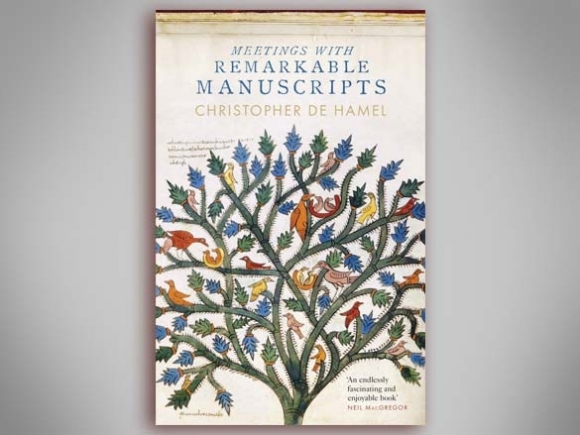Thanks to the librarian who ordered this book

How did this happen?
I treasure my local public library for its friendly staff, its vibrant programs for my grandchildren, its many spacious tables, its twin carrels for study and privacy, its sun-lit vestibule where patrons may eat lunch and drink coffee while reading, typing on their laptops, or visiting with friends. The collection of books is unremarkable, but adequate. All in all, I would judge this library a cut above many comparable institutions. The congenial atmosphere is conducive to work, and I come here several afternoons a week to escape my apartment, to work, write, and read, and to browse the stacks when I need a break.
Still, as I say, the collection is nothing special. So how, I wondered this past week, or better yet, why did the library acquire Christopher De Hamel’s Meetings With Remarkable Manuscripts: Twelve Journeys into the Medieval World (Penguin Press, 2017, 632 pages)?
Why had a library with unpretentious holdings selected such a work for purchase? I had never heard of De Hamel or of Meetings With Remarkable Manuscripts, but there the impressive tome sat, hefty and formidable, a battleship among rowboats, dominating by its title, girth, and scholarship the other new books and best-sellers, the biographies of pop stars, the cookbooks, religious tomes, and those self-help paperbacks whose hold on readers is generally as ephemeral as autumn leaves.
Who on earth in our community would read Meetings With Remarkable Manuscripts? And more to the point, what member of the acquisitions staff would order so costly a volume?
Visiting the book for a quarter hour or so shot down these first impressions. Meetings With Remarkable Manuscripts, I decided, might well appeal not only to the select few with an interest in the Middle Ages or illuminated manuscripts, but also to anyone else who might enjoy spending time with an author whose words make history and art come alive.
Related Items
In his “Introduction,” De Hamel, a cataloguer of medieval manuscripts for Sotheby’s, the premier British auction house, as well as a fellow and former librarian at Cambridge University, explains that while we can physically stand in the presence of China’s Great Wall or Botticelli’s “Birth of Venus,” most of us would find it impossible to see, much less touch, the remaining great manuscripts of the Middle Ages. To protect these fragile treasures, museums and libraries have erected near-impenetrable bureaucratic barricades. “It is easier,” writes De Hamel, “to meet the Pope or the President of the United States than it is to touch the Tres Riches Heures of the Duc de Berry.”
Because the general public can’t join the paleographers allowed to examine these manuscripts first hand, De Hamel brings the manuscripts to us. Using several hundred pictures and his vast knowledge of these works of art and literature, De Hamel relates their history and his own adventures in gaining access to them in a style as warm and genial as if we were sitting across from him in pub.
In his discussion of the Carmina Burana, for example, De Hamel opens with a memory of a teacher in his sixth form Latin who brought to class the recording of Carl Orff’s Carmina. In my own Latin II and III classes, I also used Orff’s Carmina, and with the same excellent results. The wild music — think of the soundtrack to “Lord of the Rings” — coupled with the lyrics about love, drinking, and the wheel of fortune are ambrosia and honey to students who have endured months of subjunctive verb forms and the various meanings of “cum”.
De Hamel then whisks us off from his student days into the present, when the staff of Munich’s Bayerische Staatsbibliotek, one of the grand libraries in Europe, allows him access to the manuscript. De Hamel dons the library’s requisite white gloves, opens the book, and escorts us through its pages, sharing some the Latin and its English translation, and adding fascinating personal comments during his tour, such as how the gloves became filthy from touching 800 years of accumulated dust, the relationship between Carl Orff’s Carmina Burana and Nazism, and the number of online hits the Carmina Burana has received vis-à-vis other such manuscripts. (Probably because of Orff’s music, the Carmina Burana wins hands down.)
Meetings With Remarkable Manuscripts is a dipper book, a gleaming pool of words and illustrations into which we can plunge where and when we wish. Reading it through cover-to-cover might prove too daunting an undertaking for most of us, but I am certain I shall visit and revisit its pages, finding in the illustrations and fine prose the same delight the book has brought this past week.
A final note: I considered tracking down the librarian who had ordered Meetings With Remarkable Manuscripts to offer congratulations on selecting such a pearl of a book. After some consideration, I changed my mind, fearful that my inquiry and felicitations might inhibit rather than offer encouragement. I therefore offer my appreciation here.
Kudos to you, whoever you are, the perspicacious librarian who brought this wonderful book into the library.
You hit it out of the park with this one, baby.
And to any readers of this review: the holidays are fast upon us. If you have a loved one or friend who likes books, art, history, or any combination of these, Meetings With Remarkable Manuscripts may be just the gift from you.
(Jeff Minick is a writer and teacher. This email address is being protected from spambots. You need JavaScript enabled to view it..)









